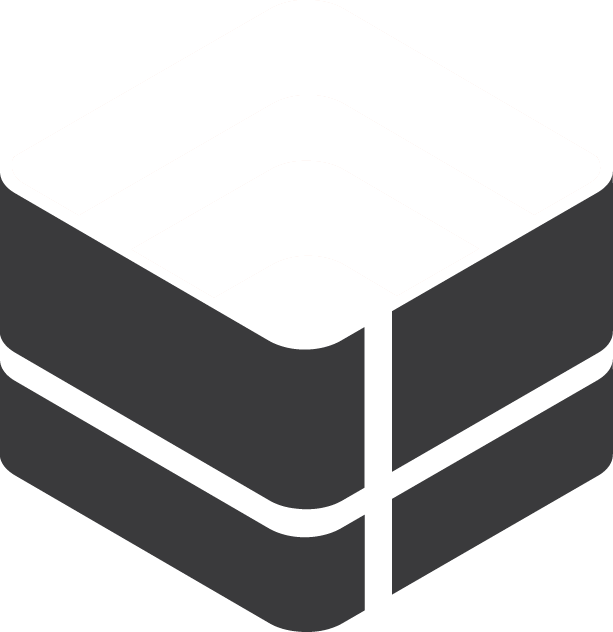Getting Started with DeskDirector
DeskDirector Portals
Browser Support
What is the DeskDirector Admin Portal?
What is the DeskDirector TECH Portal?
What is the DeskDirector Client Portal?
Desktop Portal
Managing Your Account
Pricing & Subscription Plans
Deskdirector - Sign up walk through
Managing your DeskDirector Subscription
Admin Essentials
Release Notes
Enabling Master Admin
Permissions & Feature Configuration (Tokity)
Permissions & Feature Configuration (ConnectWise/Autotask Partners)
Automatic Contact Creation
The Developer Corner
Monitoring Portal Usage
DeskDirector Features Overview
Desktop Portal Version Differences
Logging in to DeskDirector
User Profiles & Profile Pictures
Office Hours
Using Markdown
How Searching Works
Embedding Help Page Media
Get started with the DeskDirector Power Automate Connector
Features
Portal Customization
Service Catalogue
Forms
Getting started with DeskDirector Forms
DeskDirector Forms - Question Types in Detail
Dynamic Form Content
Communication
Actionable Messages for Emails
Real-Time Chats
Notifications
Email Notifications
Email Template Engine
Surveys
Broadcasts
Generative AI
DeskDirector with Generative AI
Setting up AI Service Providers
AI Assistants in DeskDirector
Custom Tools for AI Assistants
Knowledge Bases for AI Assistants
Ticket Summary for Tech Portal
Advanced
Login & Authentication
Contact & User Groups
Approvals
Task Lists
The Learning Center
Group Tags
Custom Domains
File Storage
Portal Deep Linking
Clean Tickets
Contacts
Accounts
Service Dashboard
Auditing and Analytics
Integrations
ConnectWise
ConnectWise Custom Menu Item for DeskDirector
ConnectWise
ConnectWise Quotes & Invoices
ConnectBooster
ConnectWise Sell
ConnectWise - Avoid Aggressive Notifications
AutoTask
Switching or Merging PSAs
QuoteWerks
Wise-Pay
TimeZest
BiggerBrains
OneNote Notebooks
Integrations - Frequently Asked Questions
IT Glue
Microsoft Teams App
Introducing the DeskDirector for Microsoft Team App
Installing the Microsoft Teams App (Client Mode)
Installing the Microsoft Teams App (Tech Mode)
Setting up Tags for Teams Discussions (Tech)
Branding the DeskDirector Teams App
DeskDirector Teams App Notifications
User Groups Integration with Microsoft Teams
Setting up Content Security Policy (CSP)
Advanced topic: Setting up Tech & Client Mode in the same tenancy
Integrating Microsoft Teams with DeskDirector Tech Portal
Smart Alerts for Tech Users
Microsoft Power Automate
Actions
Solutions
Power Automate Template Gallery
Featured Solution: Teams Ticket Discussion
Featured Solution: Ticket Briefing
Introduction to Power Automate
Power Automate Connector - Setting up your first flow
DeskDirector Power Platform Connector Reference
DeskDirector Connector Triggers
Troubleshooting
Troubleshooting via Web Developer Tools
Desktop Portal - Common Issues
Contact & Service Agent Impersonation
Diagnose Entities Tool
DeskDirector Desktop App - Installation Issues
Troubleshooting DeskDirector Connection Issues
Login & Authentication - Common Issues
Permissions & Access - Common Issues
Tickets & Chats - Common Issues
Approvals - Common Issues
Email & Email Delivery - Common Issues
PSA Entity Syncing - Common Issues
PSA Integration - Common Issues
ConnectWise Integration - Common Issues
Autotask Integration - Common Issues
ConnectWise Audit Trail - Exporting API Logs
Microsoft Teams App - Common Issues
Contact DeskDirector Support
Security
Glossary
Archived
- All Categories
- Archived
- Handling Chat Requests
Handling Chat Requests
Via Tech Portal
Receiving chat requests
Chat request notifications appear on the top-left side of the DD Tech Portal
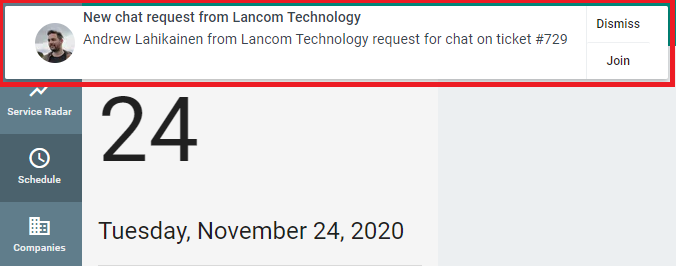
You will only receive these notifications if you are available. See this article for more information about presence. Chat requests will also show up in the chat session manager.
If you don't have your TECH tab or browser window visible, a persistent notification sound will be played and a browser notification will pop up to get your attention.
Joining chat requests
When you click Join on the chat request notification a chat window will pop up at the bottom of the screen. From here you will be able to chat with your customer
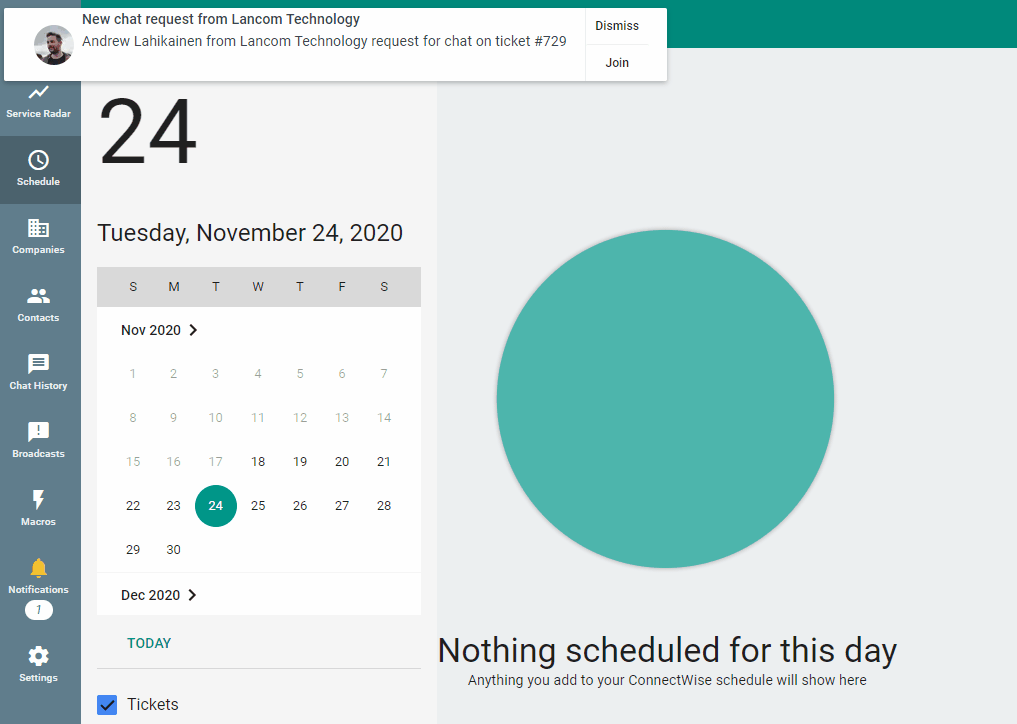
Ending chat sessions
Once you have solved the customers request, you can end the chat session. To do this, click the menu button on the chat window. This will bring up the chat menu and from here you can click 'End chat session'.
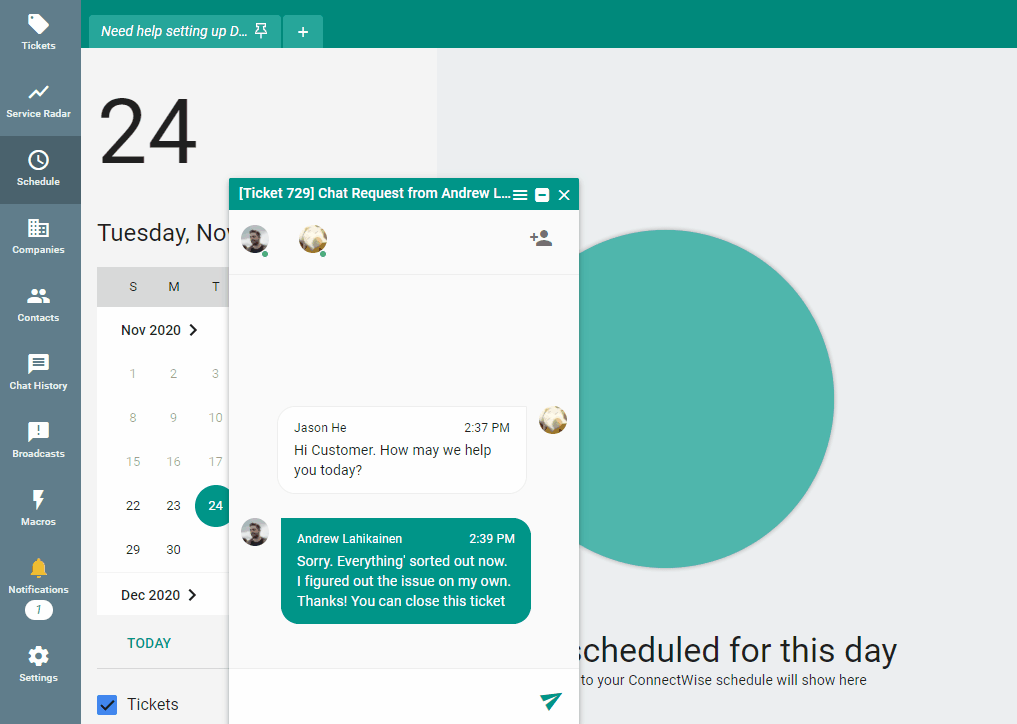
The end user will be notified that the chat has finished and will no longer be able to send you messages. A log of the chat will automatically be attached to the corresponding ticket.
Leaving the chat session
After the chat session has been completed, you will now have the option to leave the chat session. Just click the leave button on the chat window toolbar, or click the "Leave Session" button on the system message that is displayed inside the chat window.
Following up on abandoned chat requests
Abandoned chat requests should be followed up on as soon as possible. You can easily get back in touch with the customer by sending a push chat request to them from the ticket (providing they are online).
After you have got in touch with the client and solved their request you can close the chat session. Just hit the End Session button on the chat session card in the chat session manager

and fill out the dialog:

Following up on callbacks
The process for following up on callbacks is very similar to abandoned chat requests, but you will be given more information from the client. They will provide you with a phone number to ring and optionally, a message. You can click on these phone numbers directly from the chat session card to call using your phone system software.
Client Portal
Receiving chat requests
A chat request from a technician to a user will cause a chat dialog to open in the Portal, automatically joining the user to the conversation.
From here, the technician can immediately start sending messages to the user.
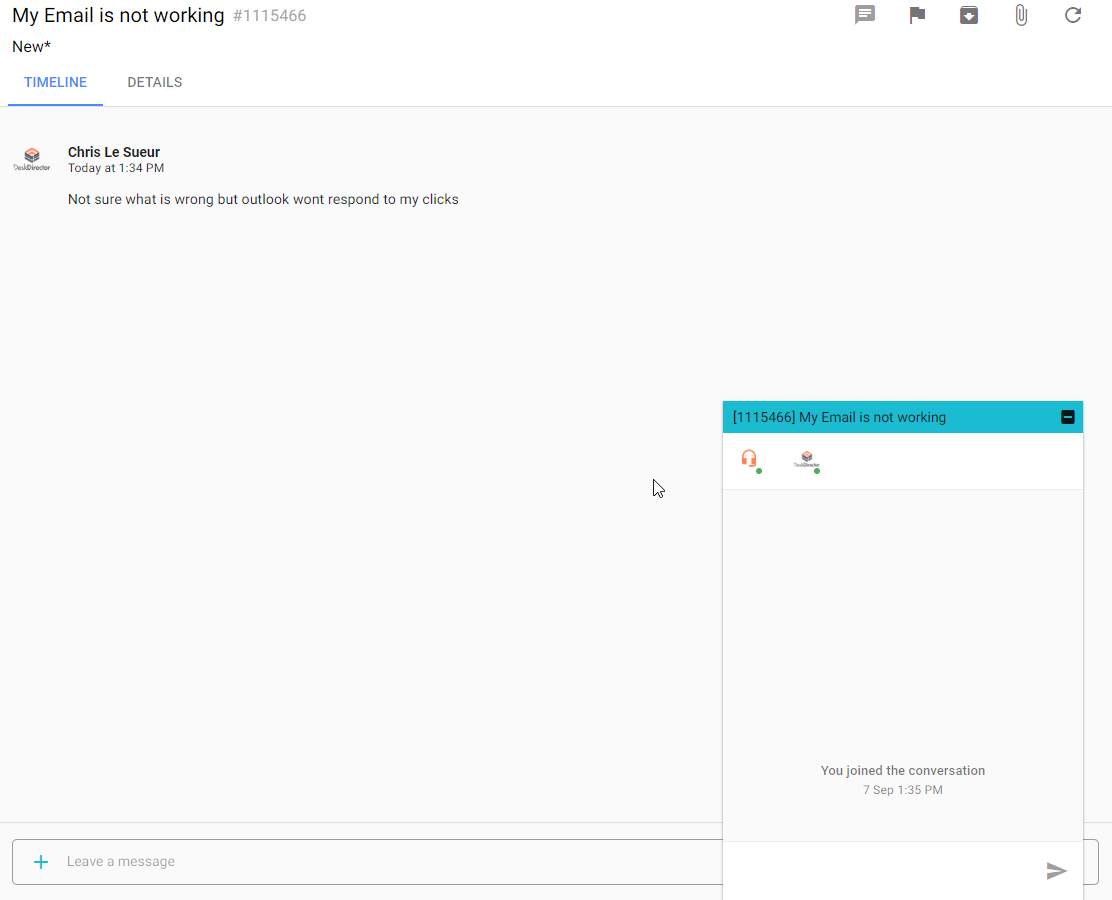
Chat requests will also create a Web Notification or a OS Desktop Notification if the installed client is running
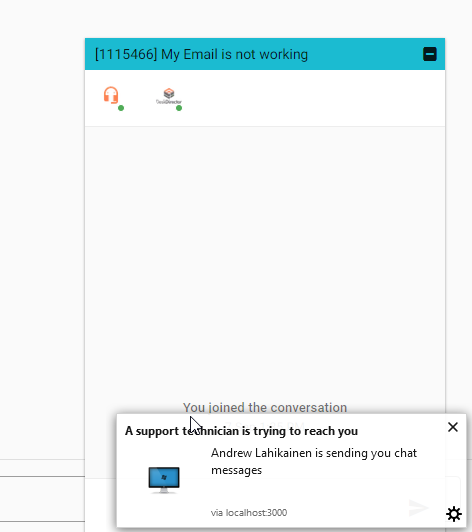

Ending and leaving chat sessions
There are only a few situations where the client user will be able to end their own chat session.
- When they have created a new chat request, but no one has answered within 1 minute.

- When they have created a new chat request, but it is currently outside of your support hours, as configured inside of your
Office Hours

- When they have been communicating with an engineer, but there has not been any chat activity for more than 1 hour

In all other situations, the burden is on the engineer to formally complete the conversation. Once an engineer has ended a chat session, the user will be presented with the ability to leave

